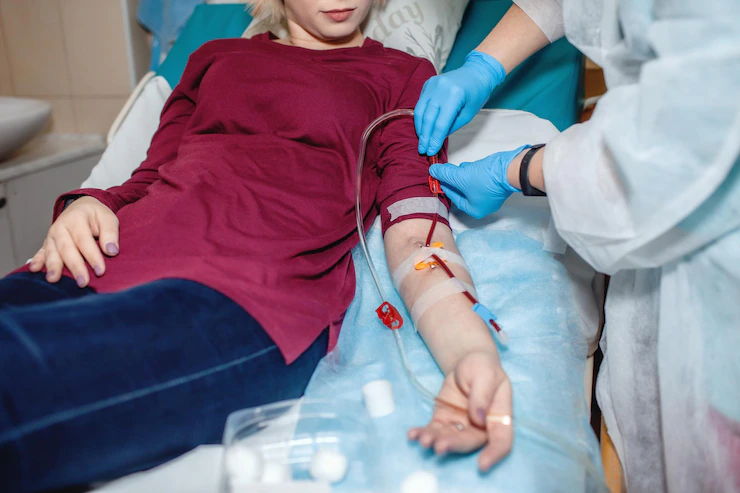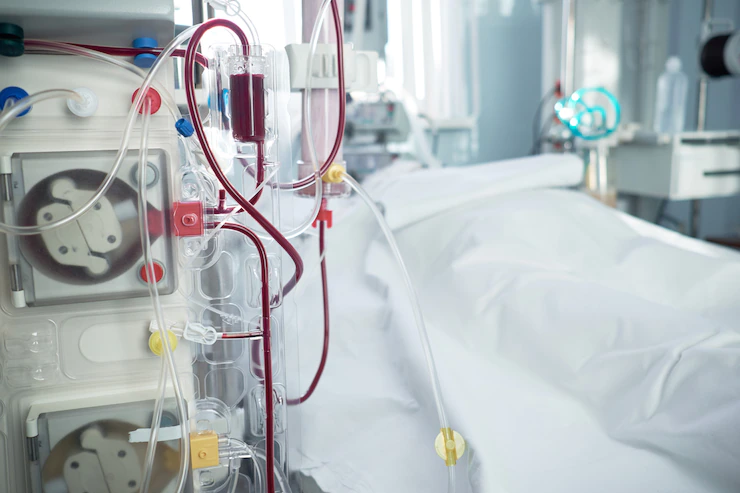Fever During Dialysis Treatment - How To Prevent It
Fever during dialysis treatment should raise suspicion of an endovascular infection since fever in dialysis patients is often caused by respiratory or gut illnesses. Fever is a relatively uncommon symptom linked to autoimmune diseases and malignant tumors. A thorough assessment can reveal the cause of fever during dialysis treatment.
Author:Suleman ShahReviewer:Han JuJul 28, 2023120K Shares1.6M Views

Fever during dialysis treatmentshould raise suspicion of an endovascular infection since fever in dialysis patients is often caused by respiratory or gut illnesses.
Fever is a relatively uncommon symptom linked to autoimmune illnesses and malignant tumors.
A thorough assessment can reveal the cause of fever during dialysis treatment.
Fever and bacteremia during hemodialysis may be the initial signs of an indolent vascular access infection.
Patients undergoing hemodialysis who develop fever should have blood collected to test for infection.
Extremely low white blood cell counts and rapid increases in blood flow via a colonized vascular access device can occur early in hemodialysis treatment and may contribute to this symptomatology.
Some cases of fever and bacteremia have been linked to hemodialysis equipment.
There are many ways in which the blood may get contaminated with aquatic organisms, including a breach in the system, a tainted water supply, fast bacterial growth in dialysate, or patient colonization by contact.
Side Effects Of Dialysis Treatment
When kidney function has declined to the point that dialysis is necessary, it saves patients' lives.
Depending on your current healthstatus and whether or not you are maintaining a healthy diet and enough hydration intake, the intensity of your side effects may range from moderate to severe.
If you listen to your doctor and other medical professionals, you should be able to control most of your symptoms.
Hernia
A hernia is a potential adverse effect of dialysis.
The placement of a catheter to enable dialysis fluid into and out of the abdominal cavity might weaken the abdominal muscles that support your internal organs.
When you perform an exchange (the process of filling, storing, and draining dialysis solution), the dialysis solution exerts strain on these already weak muscles.
This may result in a rip through which the organs might push out.
A hernia can only be repaired surgically.
Feeling Overstuffed
Some dialysis patients find eating difficult because the dialysis solution makes them feel full.
Although eating less may make you feel better, it might lead to malnutrition.
Bloating And Weight Gain
You're not alone if you're experiencing bloating and weight gain.
Patients on peritoneal dialysis often complain about these issues.
The fluid bloat from the dialysis solution accounts for some of the weight.
Weight gain may also occur due to the sugar in the dialysis solution being absorbed by the body and leading to weight gain.

The Top 5 Side Effects of Kidney Dialysis | Hemodialysis Treatment
Low Blood Pressure
Low blood pressure is the most frequent hemodialysis adverse effect, which may occur when too much fluid is removed from the blood during treatment.
This creates a reduction in pressure, which causes nausea and dizziness.
Muscle Cramps
Some persons have muscular cramps when too much fluid is eliminated or removed too rapidly.
Blood Clots
A blood clot may form in access.
Check your access regularly for the thrill (the pulse felt in the fistulaor graft) to ensure it is operating correctly.
Itchy And Dry Skin
There are various possible reasons, but it is widely assumed that elevated phosphoruslevels are to blame for itchy skin.
Because dialysis can not correctly remove phosphorus, foods containing phosphorus are prohibited from the renal diet.
Dialysis patients are also prone to dry skin, which may cause itching.
Infection
Peritonitis, an infection at the catheter site, is a possibility.
Peritonitis is characterized by fever, nausea, vomiting, and stomach discomfort.
If you have an infection, your dialysis fluid may seem murky.
The key to preventing extensive infection is to treat peritonitis as soon as possible.
Sexual Side Effects
Dialysis may result in sexual side effects such as lack of libido, erectile dysfunction, and vaginal dryness.
Mental Illness
Management And Preventive Measures
Following preventive measures are adopted for fever during dialysis treatment:
- Bacterial and endotoxin levels in water and dialysate must be maintained at or below the Association for the Advancement of Medical Instrumentation's recommended thresholds.
- Support the "fistula first" movement.
- It is recommended that you utilize a disposable dialysis unit whenever feasible.
- Iron preparations should not be given intravenously during bacterial infection outbreaks.
- Use of aseptic methods and proper hand washing before gaining vascular access are best practices.
- Following standard procedures in the dialysis unit, including mask wear by both the provider and the patient, may minimize contamination of the hub of a tunneled dialysis catheter during use, which is one of the significant risk factors for catheter-related bacteremia.
- When accessing dialysis catheters, nurses and technicians should always practice good hand hygiene, use non-sterile gloves, and utilize a mask. To reduce the risk of contamination, washing one's hands before putting on and after taking off gloves is essential.
- When the catheter and dialysis tubing is attached to and removed from the patient, the patient should also wear a mask.
Vaccination In Dialysis Patients
Patients on dialysis have a poor antibody response to several routinely administered vaccinations.
It has been hypothesized that abnormalities in T lymphocytes and antigen-presenting cells are to blame for the altered acquired immunity seen in end-stage renal disease patients.
Nevertheless, almost all dialysis patients should be immunized against hepatitis B, influenza, pneumococcus, and tetanus/diphtheria.
Except for hepatitis B, these vaccinations are administered at the same level as those given to the general public.
Antibodies against hepatitis B virus (HBV) are produced by vaccination in around 50-60% of dialysis patients.
Hepatitis B vaccination reduces the risk of infection in individuals undergoing hemodialysis by 70% compared to those who have not received the vaccine.
Those with end-stage renal disease should get 40 micrograms per dosage (mcg/dose) of the vaccine, double the recommended dose for patients without end-stage renal disease.
Vaccines should be injected intramuscularly.
Patients with severe chronic kidney disease should ideally begin a vaccine series as soon as the necessity for dialysis is anticipated.
Avoid being tested for HBsAg for at least three weeks after receiving the vaccine.
When a patient's antibody response is insufficient, a second three-dose series may be given.
As with other vaccinations, pneumococcal vaccination responses are unsatisfactory in end-stage renal disease patients.
The dose is the same as that given to the general public, and booster shots are administered based on how well the body responds to the first shot.
Every year, people should get shots against the flu.
Empiric Antibiotic Therapy
After blood cultures have been taken, immediate antibiotic treatment is required for both gram-positive and gram-negative organisms.
In the final 60 minutes of each dialysis session, a loading dosage of 1 to 1.5 g of vancomycin may be given, followed by 500 mg in the last 30 to 60 minutes of successive dialysis sessions.
After dialysis, outpatients might have their ongoing dose determined by plasma levels.
Cefazolin 20 mg/kg is a suitable replacement for methicillin against methicillin-resistant staphylococcus aureus after each dialysis treatment.
Patients with a penicillin or cephalosporin allergy are better off using vancomycin.
If a gram-negative bacterial infection is diagnosed, ceftazidime treatment may be continued.
Antibiotic Lock
Antibiotic locks may be used with systemic antimicrobial treatment as an alternative for people with less severe infections and no urgent need for catheter removal.
These solutions are instilled (or "locked") into each catheter lumen after each dialysis session throughout the length of systemic antibiotic treatment and generally consist of a combination of an anticoagulant (heparin or citrate) and a high concentration of an antibiotic.
Antibiotic combination locks may include vancomycin and heparin, vancomycin/ceftazidime/heparin, ceftazidime/heparin, or cefazolin/heparin.
A pharmacist or an experienced nurse ideally prepares these solutions before being injected into the catheter's lumen.
No benefit is gained by not changing the catheter or utilizing antibiotic lock solutions in CRB patients.
Temperature Regulation During Dialysis
Because the blood is returned to the patient in thermal equilibrium with the dialysate, variations in dialysate temperature may increase or drop body temperature during hemodialysis.
Even a dialysate temperature equivalent to the patient's tympanic membrane, mouth cavity, or axilla might cause cutaneous vasodilation, cardiovascular instability, and hypotension.
Changing the dialysate temperature may avoid this cycle.
Many hemodialysis patients' cardiovascular stability has improved by lowering their dialysate temperature from 37 to 34-35.5 degrees Celsius.
A minor change in body temperature may have huge cardiovascular repercussions. Hence the practitioner must constantly check blood temperature.
Vasodilation and shivering thresholds are separated by 0.3 to 0.8 degrees Celsius.
Improve hemodialysis by using equipment that monitors arterial and venous blood temperatures and alters dialysate temperature automatically, keeping the patient, not the dialysate, isothermic.
- Monitoring arterial and venous temperatures while manually adjusting dialysate temperature to maintain arterial (and body) temperature stability.
- Monitoring peripheral (oral, tympanic) temperatures at regular intervals and adjusting dialysate temperature to maintain body temperature.
- Using 37.0 degrees Celsius dialysate temperature in all patients unless contraindicated.
People Also Ask
Which Infections Are Common In Dialysis Patients?
Exit-site infections, tunnel infections, and catheter-related bacteremia are all possible complications of tunneled dialysis catheter usage (CRB).
Does Dialysis Raise Body Temperature?
Since the blood is returned to the patient in thermal equilibrium with the dialysate, variations in the dialysate temperature may raise or lower body temperature during hemodialysis treatments.
How Do You Treat Fever And Chills During Hemodialysis?
As a result of this uncertainty, broad-spectrum antibiotics are often prescribed as an empirical measure to all hemodialysis patients who report fever.
What Causes High Fever In Dialysis Patients?
An infection often causes fever in dialysis patients in the bronchopulmonary system, the urinary tract, or the access site.
Most fever cases in dialysis patients may be attributed to these "main three" sources.
Conclusion
The range of infections in dialysis patients has not changed much.
Managing fever in dialysis patients requires a realistic approach from the clinician and cautious nursing during dialysis.
When the source of the fever is identified, the appropriate treatment plan may be initiated immediately.
When the origin of the fever is unclear, the diagnosis should be based on the severity of the condition.

Suleman Shah
Author
Suleman Shah is a researcher and freelance writer. As a researcher, he has worked with MNS University of Agriculture, Multan (Pakistan) and Texas A & M University (USA). He regularly writes science articles and blogs for science news website immersse.com and open access publishers OA Publishing London and Scientific Times. He loves to keep himself updated on scientific developments and convert these developments into everyday language to update the readers about the developments in the scientific era. His primary research focus is Plant sciences, and he contributed to this field by publishing his research in scientific journals and presenting his work at many Conferences.
Shah graduated from the University of Agriculture Faisalabad (Pakistan) and started his professional carrier with Jaffer Agro Services and later with the Agriculture Department of the Government of Pakistan. His research interest compelled and attracted him to proceed with his carrier in Plant sciences research. So, he started his Ph.D. in Soil Science at MNS University of Agriculture Multan (Pakistan). Later, he started working as a visiting scholar with Texas A&M University (USA).
Shah’s experience with big Open Excess publishers like Springers, Frontiers, MDPI, etc., testified to his belief in Open Access as a barrier-removing mechanism between researchers and the readers of their research. Shah believes that Open Access is revolutionizing the publication process and benefitting research in all fields.

Han Ju
Reviewer
Hello! I'm Han Ju, the heart behind World Wide Journals. My life is a unique tapestry woven from the threads of news, spirituality, and science, enriched by melodies from my guitar. Raised amidst tales of the ancient and the arcane, I developed a keen eye for the stories that truly matter. Through my work, I seek to bridge the seen with the unseen, marrying the rigor of science with the depth of spirituality.
Each article at World Wide Journals is a piece of this ongoing quest, blending analysis with personal reflection. Whether exploring quantum frontiers or strumming chords under the stars, my aim is to inspire and provoke thought, inviting you into a world where every discovery is a note in the grand symphony of existence.
Welcome aboard this journey of insight and exploration, where curiosity leads and music guides.
Latest Articles
Popular Articles

